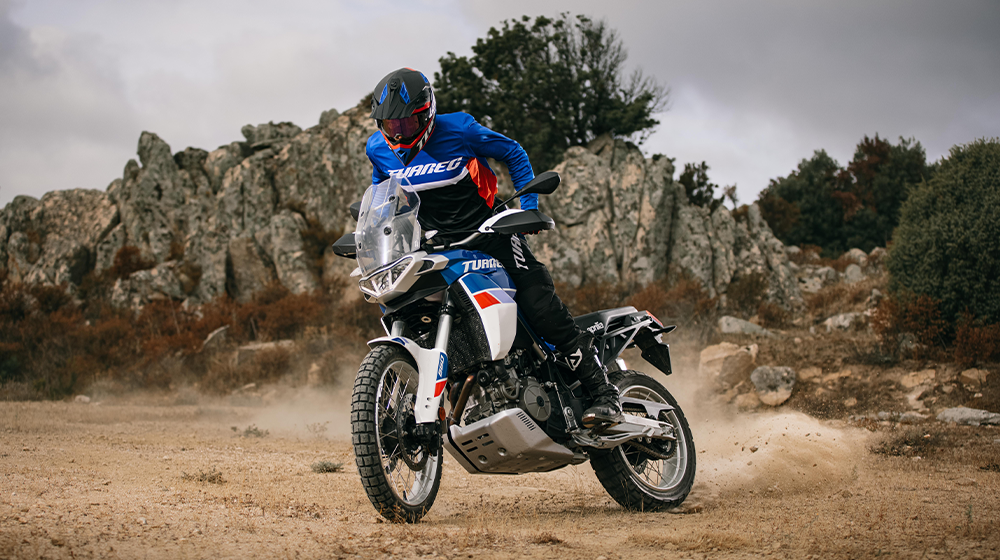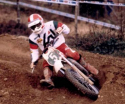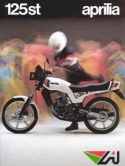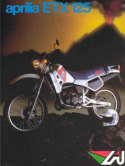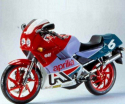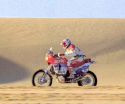-
1983
The start of the Eighties was a time of severe crisis in the national and European motorcycle market as a whole. It was during these difficult years that the foundations were laid for prestigious new goals, born from an extraordinary passion for motorcycles and from a trust in the recovery of the Italian motorcycle market.
No longer restricted to cross bikes and mopeds; production was to be directed towards new lines, extending the range to enduro bikes, trial bikes and road bikes with engine sizes ranging from 50 to 600 cc.
Backed by a dynamic, flexible organisation, Aprilia was at the same time extending its participation in motorcycle competitions. This enabled the brand to become better known at a world level and, above all, gave the opportunity to test the innovative choices made by the Noale factory, stimulating continuous technological updates and creating an essential test bench for the training and updating of technical staff.
In spite of the state of crisis, in the early Eighties Aprilia became a laboratory for ideas and projects that were to result in its great international expansion during the years to come. The first important signal of this new strategy was seen in 1983, when the first Aprilia road bike was presented to the public: the ST 125.
With a strong personality, streamlined and elegant, the ST 125 handled extremely well both when pushed to its limits and during normal on-road use, and it gained the favour of the specialist press.
The following year saw the arrival of the STX, an improved and more sporting version of the ST, and the first enduro bike produced by the Venetian factory, the ET 50, whose small engine was a summary of all Aprilia's experience in off-road bikes.
-
1985
In 1985, in spite of the fact that this was the last year in which the works bike took part in the cross championships, the ETX was launched onto the market in a 125 and 350 version.
The choice to extend the production range, made several years earlier, has proved to be long-sighted, while the first signs of a contraction in the cross market were seen, resulting in this sector becoming extremely specialised and encouraging the growth of road and enduro bikes.
After its first experiences in Trial with the TL 320 in 1981, in 1985, the first year in which it competed in the World Championship, Philippe Berlatier's Aprilia made fifth place. In the same year the extraordinary adventure in the World Racing Championship commenced, with the GP 250 ridden by Loris Reggiani.
It was a challenge considered rash by many observers, that of a small Italian factory that, without any experience, went onto the track and took on the powerful Japanese.
But at the end of the first season the Aprilia GP 250 was sixth in the world championship ratings. This is an incredible result, when you consider the tiny racing team, entirely experimental, that was working during the first year.
-
1986
The leap of quality made by Aprilia can also be seen in the smaller models, with the appearance of the AF1 in 1986, a vehicle that, both aesthetically and technically, recalls its more powerful sporting sisters, and in the field of enduro, where the ETX is joined by the Tuareg, inspired by the bikes used for the great African rallies, very much in fashion during those years, with a huge tank and wide range of accessories.
-
1989
Along with the technological content, all Aprilia bikes can be distinguished by their entirely new and original design and graphic style, which breaks the chromatic monotony of the motorcycle world, based on the traditional red and silver.
Aprilia has a strong belief in the force and ability of design to create emotions, and bring an increasingly youthful public into the world of motorcycles. If the ETX from the mid-Eighties was the first bike to be characterised by a tone-on-tone colour scheme, the bikes in the AF1 series from 1986 to 1991 were of great effect, appearing to be completely different models simply thanks to their chromatic transformations, while retaining a similar frame.
That of colour and design is a route that, after being inaugurated by Aprilia, lead to a trend that went on to be followed by almost all the other manufacturers, so much so that the Milan Motor Show of 1989 was said to be an "Aprilia Show" because of the generalised use of pastel colours. In the field of sport, the Eighties also saw an amazing leap in quality.
Tuareg 600 Parigi - Dakar
Haute Couture on the two wheels
Find your bike
Photo galleries
History
Back


